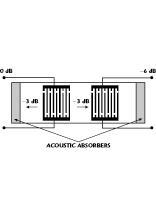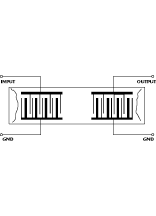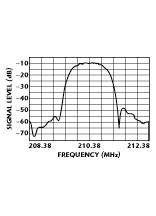SAW IF filters in Mobile Communications Networks
Sunder Gopani
Sawtek Inc.
Orlando, FL
As mobile communications networks are making headway in their global expansion, two digital systems are emerging as standards: the Global System for Mobile communications (GSM) and code-division multiple access (CDMA). GSM is implemented predominantly in Europe and is expanding rapidly to many countries, particularly China. The system is operated at 900 MHz with a second version being scaled to 1800 MHz (DCS 1800) to expand capacities. CDMA is a more recently developed digital technology air interface that is being implemented in the US. The CDMA standard has also been adopted by other countries, including South Korea, Mexico and Russia. CDMA is operated at both the 900 MHz cellular band and the 1900 MHz PCS band.
GSM and CDMA standards are based upon different architectural principles. GSM makes use of time-division multiplex. Eight users occupy a physical frequency channel of ±100 kHz. Frequency planning plays a critical role in GSM systems to reduce filtering demands and increase capacity. CDMA uses spread spectrum technology in which a wide range of frequencies are transmitted. With CDMA, multiple users can occupy a single frequency band of 1.23 MHz by using spread spectrum techniques based on orthogonal codes. This technique requires tight power management and, hence, steep filtering is necessary to avoid receiver blocking.
Surface acoustic wave (SAW) filters have been successful in providing filtering requirements for both mobile networks standards. While SAW RF filters are used extensively in the radio cellular band, SAW IF filters are being employed in a wide range of intermediate frequencies for channel selection. This article focuses on IF filters and describes the evolution of SAW designs to meet the challenging demands of small size and weight as well as low power consumption and cost for both GSM and CDMA networks.
SAW Filter Operation
A transversal SAW filter generally consists of input and output transducers deposited on a highly polished piezoelectric substrate such as quartz, lithium tantalate or lithium niobate. A SAW transducer is typically constructed of thin  aluminum interdigital electrodes connected to bus pads of opposite polarities, as shown in Figure 1 . When an RF signal is applied across the bus pads, stress and strain are produced on the crystal, producing a SAW that propagates along the substrate. Thus, the input transducer converts electrical energy to acoustic energy. In a reciprocal manner, the acoustic wave is converted into electrical energy at the output transducer. The surface wave is sampled by the electrodes, and the transducer's frequency response depends upon the weightings of the electrodes. The transducer design is similar to the finite impulse response filter design used in digital filters. The frequency response is based solely on the finite sets of electrode weightings. It has no poles and only zeroes in its s plane. The frequency response of the filter is the product of the frequency response of each transducer.
aluminum interdigital electrodes connected to bus pads of opposite polarities, as shown in Figure 1 . When an RF signal is applied across the bus pads, stress and strain are produced on the crystal, producing a SAW that propagates along the substrate. Thus, the input transducer converts electrical energy to acoustic energy. In a reciprocal manner, the acoustic wave is converted into electrical energy at the output transducer. The surface wave is sampled by the electrodes, and the transducer's frequency response depends upon the weightings of the electrodes. The transducer design is similar to the finite impulse response filter design used in digital filters. The frequency response is based solely on the finite sets of electrode weightings. It has no poles and only zeroes in its s plane. The frequency response of the filter is the product of the frequency response of each transducer.
The physical structure of a SAW filter is simple yet rugged and reliable. No tuning is required in the field as is normally required by filters based on alternative technologies. SAW filters are manufactured using standard photolithographic processes and, therefore, permit large volume production. A large number of zeros can be implemented easily on the transducer resulting in a very steep-shaped filter with linear phase.
Conventional SAW filters are viable filter solutions in many applications, however, they have one major drawback for wireless applications: The conventional filter generally has transducers that are bidirectional radiators. Equal amounts of energy are launched in both directions, and each transducer has 3 dB bidirectional loss. Thus, conventional SAW filters inherently have 6 dB of bidirectional loss. Additionally, the filter must be intentionally mismatched to reduce triple-transit echo that can degrade the filter passband and phase performance. Typically, the conventional filter's insertion loss is in the range of 15 to 30 dB. The high insertion loss of this filter type is not desirable in many wireless applications.
Generally, low insertion loss, small size and light weight are the primary considerations in the selection of a component for a wireless application. Low cost is a must for applications such as mobile telephones, whereas components for a base station can bear higher insertion loss and cost but demand much steeper shape and rejection.
Low Loss SAW Filters
The SAW filter is passive and inherently a very low power consumption device. However, the high insertion  loss of the conventional design may limit its use in many wireless applications. Figure 2 shows a low loss SAW filter known as the single-phased unidirectional transducer (SPUDT). The SPUDT filter has acoustic reflectors deposited within the transducer, which are positioned in such a manner that acoustic waves add constructively and destructively in the forward and reverse directions, respectively. Thus, the device is a unidirectional transducer that eliminates much of the bidirectional loss of the conventional filter. In addition, a good SPUDT filter should perform such that the triple-transit signal cancels out the signal reflected at the reflector electrodes. Therefore, it is not necessary to mismatch the SPUDT filter to achieve low passband ripple. The insertion loss of the SPUDT generally is one-third that of the bidirectional filter. This reduction in loss is beneficial to the wireless systems in terms of lower noise figure, greater dynamic range and a lower gain stage requirement. Ultimately, the lower insertion loss helps to extend the range of handsets and improve battery life.
loss of the conventional design may limit its use in many wireless applications. Figure 2 shows a low loss SAW filter known as the single-phased unidirectional transducer (SPUDT). The SPUDT filter has acoustic reflectors deposited within the transducer, which are positioned in such a manner that acoustic waves add constructively and destructively in the forward and reverse directions, respectively. Thus, the device is a unidirectional transducer that eliminates much of the bidirectional loss of the conventional filter. In addition, a good SPUDT filter should perform such that the triple-transit signal cancels out the signal reflected at the reflector electrodes. Therefore, it is not necessary to mismatch the SPUDT filter to achieve low passband ripple. The insertion loss of the SPUDT generally is one-third that of the bidirectional filter. This reduction in loss is beneficial to the wireless systems in terms of lower noise figure, greater dynamic range and a lower gain stage requirement. Ultimately, the lower insertion loss helps to extend the range of handsets and improve battery life. 
Figure 3 shows the typical performance of a 210.38 MHz SPUDT filter used inCDMA PCS handsets. The filter has an insertion loss of 7 dB, passband width of 1.5 MHz and rejection bandwidth of 2.3 MHz. The 1.5 MHz bandwidth is greater than the 1.23 MHz information bandwidth. Typically, SAW filters are designed steeper than actual requirements to accommodate manufacturing tolerances and drift over temperature range of operation. The filter is mounted in a surface-mount package with dimensions of 15 mm x 6.5 mm x 1.65 mm.
While the lower insertion loss of SAW filters has great benefits for wireless networks, other requirements such as size, weight and cost play a major role in the acceptance of a component for mobile communication systems, particularly handsets. For wireless applications, SAW filters have been able to move successfully from dual in-line to surface-mount packages. Industry-standard surface-mount packages have been modified to improve the internal ground plane to reduce the feedthrough effect that degrades the filter's performance. The surface-mounted SAW filter allows a low profile and less weight. In addition, manufacturers are able to use both sides of the printed circuit board, thereby increasing the component density.
Size, weight and cost normally go hand in hand. Smaller size implies lower weight for the same package type. Since SAW die generally are mounted in the smallest package that can accommodate the die, a smaller die requires a less expensive package. Additionally, a smaller die also implies more die per wafer, thereby reducing the cost of each die. Consequently, the real challenge for SAW filter designers is to meet the filter requirements in the smallest package.
The size of the SAW filters usually is determined by center frequency, bandwidth and shape factor. Since the sampling electrode size is proportional to the wavelength of the carrier, a lower IF dictates a larger die size for the same filter conditions. Thus, the trend for manufacturers is to move to higher IFs. For the same center frequency, the filter is longer for a narrower bandwidth and steeper shape factor. For a Gaussian or unweighted filter, the bandwidth is inversely proportional to the impulse length. A steeper-shaped filter requires more time sidelobes to formulate the shaping requirements just as an infinite time domain sinx/x function would provide a perfectly rectangular frequency response.
The Reflective Low Loss Filter
 Figure 4 shows a reflective low loss filter. In this structure, a reflector is inserted between the input and output SPUDT transducers. The reflectors of the input and output transducers are modified so that, along with the inserted reflectors, resonant cavities are formed. Thus, a resonant response is superimposed on the frequency response of the SPUDT structure.
Figure 4 shows a reflective low loss filter. In this structure, a reflector is inserted between the input and output SPUDT transducers. The reflectors of the input and output transducers are modified so that, along with the inserted reflectors, resonant cavities are formed. Thus, a resonant response is superimposed on the frequency response of the SPUDT structure. This configuration provides a narrower as well as a lower insertion loss frequency response with no additional die size. Figure 5 shows the frequency response of a reflective loss filter used in the DCS 1800 system.
This configuration provides a narrower as well as a lower insertion loss frequency response with no additional die size. Figure 5 shows the frequency response of a reflective loss filter used in the DCS 1800 system.
As can be seen from the plot, the upper frequency response is shaped through the resonance of the device. The insertion loss of the filter is approximately 6.5 dB. The 1 and 45 dB bandwidths of the filter are 0.33 and 1.25 MHz, respectively. The filter is mounted in a surface-mount package with dimensions of 19 mm x 6.5 mm x 1.65 mm. Since the filter bandwidth is narrow, it is fabricated on a quartz substrate that is very temperature stable.
Multitrack Transducer Designs
A number of multitrack design approaches are available to enhance the  performance of the SAW filter. Since more than one input and output transducer are used, additional flexibility exists in the design to shape the filter. Figure 6 shows a three-track design approach. The center-to-center distance between each track is offset spatially by 120°. This configuration can be achieved easily by separating each track by one-third of a wavelength. The voltage at each of the output transducers exhibits a phase of 0°, 120° and 240°. These voltages are then added up vectorially to a zero output signal for the first transit. The output transducers appear as shorted and reflect the signals back to the input transducers. Similarly, the voltages at the input transducers cancel for the second transit. However, the third transit adds in phase. The frequency response of the filter depends upon the input and output transductions and their corresponding shorted reflection function. Since the filtering is performed through both transduction and reflections of the input and output transducers, a narrower bandwidth is achieved.
performance of the SAW filter. Since more than one input and output transducer are used, additional flexibility exists in the design to shape the filter. Figure 6 shows a three-track design approach. The center-to-center distance between each track is offset spatially by 120°. This configuration can be achieved easily by separating each track by one-third of a wavelength. The voltage at each of the output transducers exhibits a phase of 0°, 120° and 240°. These voltages are then added up vectorially to a zero output signal for the first transit. The output transducers appear as shorted and reflect the signals back to the input transducers. Similarly, the voltages at the input transducers cancel for the second transit. However, the third transit adds in phase. The frequency response of the filter depends upon the input and output transductions and their corresponding shorted reflection function. Since the filtering is performed through both transduction and reflections of the input and output transducers, a narrower bandwidth is achieved.
Figure 7 shows a three-track filter frequency response with a nominal center frequency of 210.38 MHz. The IF filter is used in PCS CDMA handsets. The filter has a low insertion loss of 10 dB (typ). The 5 and 33 dB filter bandwidths are 1.42 and 2.3 MHz, respectively. The filter is housed in a surface-mount package with dimensions of 7.1 mm x 5.5 mm x 1.65 mm. When compared to the SPUDT filter performance shown previously, the multitrack design approach enables SAW designers to achieve the required filter shaping with approximately half the die size.
SAW IF Filter Capabilities
The distribution of filtering requirements in a system is critical. The capabilities of different filter technologies are important considerations in the allocation of filter specifications. Very often, a filter with aggressive specifications will increase cost and risk significantly. Table 1 lists the capabilities of SAW IF low loss filters. While the performance of these filters can be accomplished fairly easily, not all parameters can be achieved simultaneously.
|
Table I | |
|
Center frequency range (MHz) |
40 to 600 |
|
Fractional Bandwidth (%) |
0.1 to 15 |
|
Insertion loss (dB) |
4 to 15 |
|
Near-in-rejection (dB) |
30 to 50 |
|
Ultimate rejection (dB) |
40 to 60 |
|
Shape factor |
1.5 to 4.0 |
|
Amplitude ripple (dB) |
0.1 to 1.0 |
|
Phase ripple (° ) |
1 to 10 |
|
Group delay variation (m s) |
0.02 to 1.00 |
|
Triple-transit suppression (dB) |
30 to 50 |
Conclusion
SAW design has evolved significantly over the years to meet the challenging requirements of wireless mobile communication networks. The single-phased unidirectional transducer has enabled the design of low loss SAW IF filters to improve noise figure and dynamic range and reduce excessive gain requirements. Reflective low loss and multitrack designs allow SAW designers to achieve filter shaping with smaller die size, thereby reducing cost and weight. In addition, the successful implementation of SAW filters in surface-mount packages has provided further weight and size reductions. Innovative design techniques will continue to emerge to meet the aggressive demands of wireless applications.
Sunder Gopani received his BS degree in physics with honors from Fergusson College, Poona, India in 1978. He received his MS degree in electrical engineering from the University of Central Florida in 1981. Gopani joined Sawtek in 1981 and has been involved in the analysis and design af SAW bandpass filters for both military and commercial applications. Currently, he is the company's design engineering manager. Gopani is a member of the IEEE and has published numerous technical papers regarding SAW filter technology. He has also received a patent for SAW notch filters.
